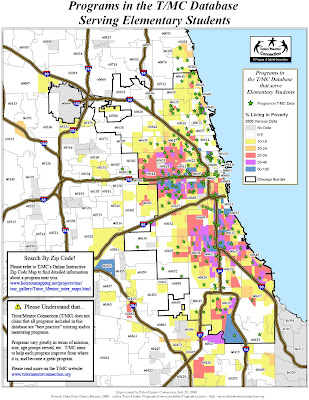However, unlike the last set of maps I posted, which show the locations of ALL known programs, this set of maps in this blog will filter the data by "age group served." In other words, what grade level are the kids at, in school?
Some programs focus their attention on Elementary school-aged students:

Others work with High School kids:

Some work with Junior High kids alone, although this is somewhat rare. The number of green stars on this map are probably a result of the fact that many programs work with a range of kids, instead of one age group alone. For instance, a program might work with ALL kids, in which case Junior High kids will attend their programs alongside High School and/or Elementary students too:
So how do you use these maps? What good does it do to see these clusters of stars?
Again, notice here that the maps contain 2000 poverty data, and remember that the T/MC mission mentions that...
The Tutor/Mentor Connection (T/MC) is dedicated to improving the availability and quality of comprehensive, long-term, volunteer-based tutor/mentor programs in high-poverty areas of the Chicago region and other large US cities through an ongoing, dynamic exchange of ideas.
... And that the major highways on most of our maps show potential volunteers how easily they can find a program alongside their normal commutes.
But why else are these maps important tools?
Well, some communities have collaborations with programs that work with differently-aged kids. Cabrini Connections, for instance works with kids in grades 7-12. (This location will appear on both the High School and the Junior High maps.) Occasionally, Cabrini Connections collaborates with neighboring programs that work with elementary kids who aren't old enough to attend Cabrini Connections. (An example of this will occur on September 27th when Cabrini Connections, Cabrini Green Tutoring, and the Chicago Lights program work together to train new, prospective, and veteran tutors/mentors, hosting a variety of workshops relevant to one-on-one tutoring/mentors of students in grades 1-12. See the calendar for more details, if interested in attending,)
This exemplifies an important purpose for these maps. A quick trip to the interactive zip code map could show potential partners/collaborators where other programs are located - programs whose specialties complement the work they are doing.
Equally important perhaps, these maps might highlight an absense of programs for a particular age group in a given neighborhood. In fact, this is one of the reasons Dan Bassill started Cabrini Connections in the first place. Seeing that Cabrini Green Tutoring was working solely with elementary kids, he recognized that the neighborhood's older kids needed a place where they could build on the important work Cabrini Green Tutoring was doing, and continue to develop their academic and job skills.
1 comment:
Mike, as you and others talk about the information in the maps, such as age group served, or type of program, I encourage you to try to quantify the number of programs showing on a map, for that category. Then when you view an area like Engelwood, or Austin, include the total number of kids age 5 to 18 in the area. For instance in East and West Englewood there are more than 20,000 kids, yet the map only shows a few programs, and we know these only serve a small number of kids.
Readers need to be thinking "how can I help existing programs become best in class at what they do" and "how can I help new programs grow in areas that are under served, or have no programs serving specific age groups".
As Mike creates these maps, we hope others will link to them in their own blogs and outreach, so we increase the number of people who include this thinking in their planning, philanthropy, and volunteerism.
Dan Bassill
Tutor/Mentor Connection
Post a Comment